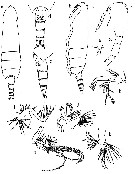|
|
 |
Fiche d'espèce de Copépode |
|
|
Calanoida ( Ordre ) |
|
|
|
Clausocalanoidea ( Superfamille ) |
|
|
|
Scolecitrichidae ( Famille ) |
|
|
|
Scaphocalanus ( Genre ) |
|
|
| |
Scaphocalanus emine Uysal & Shmeleva, 2002 (F) | |
| | | | | | | Ref.: | | | Uysal & Shmeleva, 2002 (p.46, figs.F); Vives & Shmeleva, 2007 (p.768, figs.F, Rem.); Uysal & Shmeleva, 2012 (p.909, Table I) |  issued from : Z. Uysal & A. Shmeleva in Hydrobiologia, 2002, 470. [p.47, Fig.2]. Female (from Iskenderum Bay, Levantine Basin): a, habitus (dorsal); b, idem (lateral); c, urosome (lateral, left side); d, idem (dorsal); e, rostrum (frontal view); g, A1 (5 segments only); h, A2; i, Md; j, Mx1; k, Mx2; l, Mxp. Nota: Forehead with a median crest. Head and 1st thoracic segment fused, 4th and 5th fused producing a triangular expansion which is pointed at the apex. Proportional lengths of rrosomal segments 28:16:15:8:10 = 100. Distal part of spermatheca of the genital segment extend dorsally and widen from the lateral view like a sack. Caudal rami 1.9 times longer than wide.The terminal segment of Mx2 has 3 longer vermiform and 5 amalliform sensory filaments
|
 issued from : Z. Uysal & A. Shmeleva in Hydrobiologia, 2002, 470. [p.48, Fig.2]. Female: m, P1; n, P2; o, P5. Nota: P5 with rudimentary endopod, furnished with 1 apical spine.
| | | | | NZ: | 1 | | |
|
Carte de distribution de Scaphocalanus emine par zones géographiques
|
| | | | | | | Loc: | | | E Medit. (N Lebanon Basin: Iskenderun Bay) | | | | N: | 2 | | | | Lg.: | | | (910) F: 3,2; {F: 3,2} | | | | Rem.: | côtière.
Voir aussi les remarques en anglais | | | Dernière mise à jour : 31/01/2015 | |
|
|
 Toute utilisation de ce site pour une publication sera mentionnée avec la référence suivante : Toute utilisation de ce site pour une publication sera mentionnée avec la référence suivante :
Razouls C., Desreumaux N., Kouwenberg J. et de Bovée F., 2005-2025. - Biodiversité des Copépodes planctoniques marins (morphologie, répartition géographique et données biologiques). Sorbonne Université, CNRS. Disponible sur http://copepodes.obs-banyuls.fr [Accédé le 04 juillet 2025] © copyright 2005-2025 Sorbonne Université, CNRS
|
|
 |
 |





